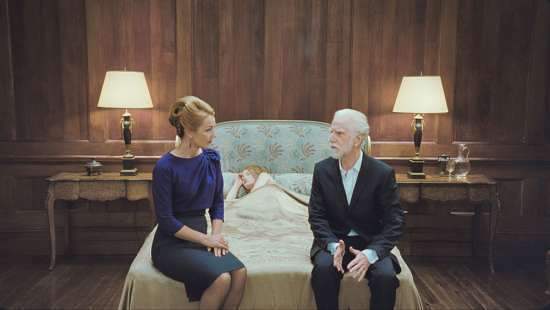 Lucy is a college student struggling to make ends meet. To that end she works in a restaurant, serves as a test subject for medical experiments, does temp work in an office and even turns the occasional trick. Responding to an ad in a campus newspaper, she finds herself with a new job, working as a server at rich dinner parties. The only thing is that he work “uniform” is fairly revealing lingerie. After a few months, she is offered a “promotion.” Going out to a stately old manor house out in the country, she takes a sleep-inducing drug and rich customers spend the night next to her. Although she is told she will not be harmed or penetrated during these sessions, Lucy’s curiosity slowly gets the better as to what is going on while she is asleep.
Lucy is a college student struggling to make ends meet. To that end she works in a restaurant, serves as a test subject for medical experiments, does temp work in an office and even turns the occasional trick. Responding to an ad in a campus newspaper, she finds herself with a new job, working as a server at rich dinner parties. The only thing is that he work “uniform” is fairly revealing lingerie. After a few months, she is offered a “promotion.” Going out to a stately old manor house out in the country, she takes a sleep-inducing drug and rich customers spend the night next to her. Although she is told she will not be harmed or penetrated during these sessions, Lucy’s curiosity slowly gets the better as to what is going on while she is asleep.
Sleeping Beauty is the debut feature from novelist Julia Leigh, directing from her own 2008 Black List script and it is a fascinating meditation on the objectification of women by society and themselves. The men and women who attend the parties that Lucy works at seem completely oblivious to the scantily glad women serving their dinner and drink, secure in the knowledge that their wealth and power can buy them anything they want, including people. When Lucy works as the sleeping companion for the rich, she becomes a symbol of lost youth for an old man or an object to control for another.
Almost every scene plays out in a single shot and by stripping down the artifice of filmmaking, Leigh is in a way forcing us to regard her characters in the same way that we would regard people in real life. The character’s images are not presented in a series of long shots, two-shots and close-ups as a manipulation of the storytelling. Instead, there is an almost voyeuristic feeling to watching their lives play out in front of us, objects for our amusement.
 Emily Browning gives a bravura performance as the emotionally closed off Lucy. Browning is very naturalistic here and there is never a moment when we get the feeling that she is “acting.” Some may criticize that Leigh doesn’t seem to give much background to any of the characters, but I think that is deliberate. We are running up against the same wall that Lucy is using to keep the world around her at bay. There may be a moment or two where a crack in that wall gives us a hint as to what has brought Lucy to this point, but there is nothing that ever gives us any concrete answer.
Emily Browning gives a bravura performance as the emotionally closed off Lucy. Browning is very naturalistic here and there is never a moment when we get the feeling that she is “acting.” Some may criticize that Leigh doesn’t seem to give much background to any of the characters, but I think that is deliberate. We are running up against the same wall that Lucy is using to keep the world around her at bay. There may be a moment or two where a crack in that wall gives us a hint as to what has brought Lucy to this point, but there is nothing that ever gives us any concrete answer.
Interestingly, Browning’s Lucy is very similar to her Babydoll character in last spring’s Sucker Punch. Both are emotionally fragile and closed-off young women who are absent paternal figures and who find themselves in situations where their sexuality has become objectified. The difference is that Babydoll uses that sexuality as a weapon to externally escape the situation where Lucy uses hers as a wall that simultaneously protects her from the outside world while imprisoning herself within its confines. But here, Leigh handles the idea much more cubtly than Zack Snyder did in Sucker Punch,and ironically, Sleeping Beauty is all the more powerful of the two films by far for it.




